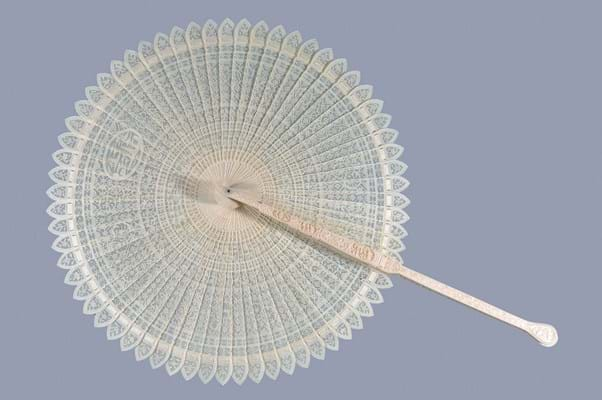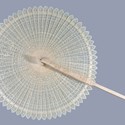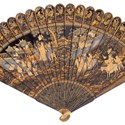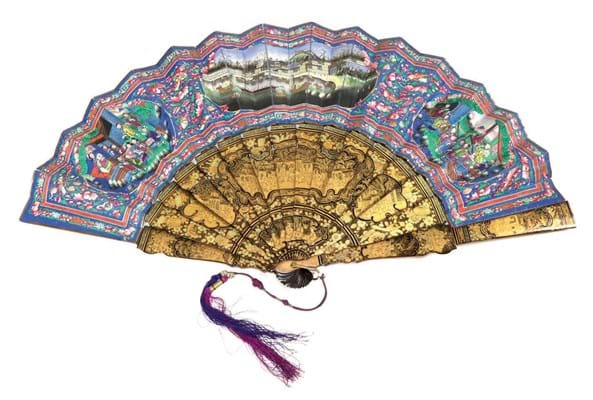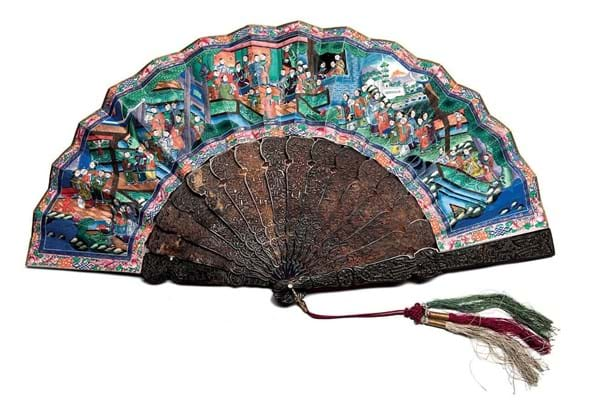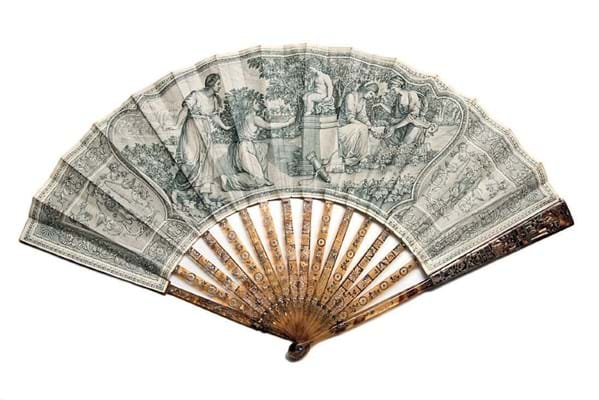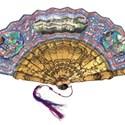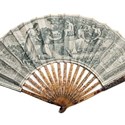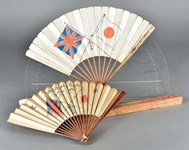Too wide-ranging and established to be described as a niche market – the London Fan Museum at Greenwich and the Sasaskawa Gallery at the Fitzwilliam in Cambridge are evidence of the general and scholastic appeal of fans – they remain a sufficiently specialist world to be protected from swings in market tastes or the demise of a few wealthy collectors.
Prices can range from a few pounds to serious five figures, and did so across the hundreds of fans on offer in April and May.
Court paraphernalia
Topping them all was one of a dozen Chinese examples offered among the 450 lots at Dreweatts' (24% buyer’s premium) Asian Works of Art sale at Donnington Priory on May 22.
Although often associated with the export trade (they were imported from China as early as the mid-17th century), fans were also part of the paraphernalia of the Qing court. Ivory was the key component.
At Dreweatts, a c.1810 Cantonese ivory cockade brisé fan was offered: cockade meaning a two-handled fan opening up to a full circle around a central pivot and brisé the term for fans of single sticks held together by a rivet at the bottom and a ribbon or thread near the top.
The 21½in high, 14½in wide (55 x 37cm) fan was carved with an oval landscape reserve on a trellis ground and the guard (end) sticks were carved with pagodas and foliage.
It was guided at £800-1200 but strong Chinese interest – possibly triggered by the catalogue reference to a very similar fan in Neville J Irons’ book Chinese Imperial Fans – took bidding to £23,000.
Further fans
Fans also featured at wide-ranging Oriental sales held by Matthew Barton (24% buyer’s premium) in London on June 6-7 and at the first such specialist sale at Bishop & Miller (19% buyer’s premium) at Stowmarket on May 24.
Barton’s sale, which was dominated by two five-figure Indian carvings of a sandstone Jina and a bronze Vishna (see ATG next week), included 10 mid-19th century Chinese fans.
All got away, generally well above estimates, at prices ranging from £600 to the triple-estimate £1500 bid for a 7½in (19.5cm) high tortoiseshell fan with gilded Buddhistic lion masks to the guards and decorated with scrollwork panels and vignettes of figures at a table.
A similarly sized black lacquer brisé fan gilded and painted with a landscape oval featuring horse riders and attendants was pitched at £300-400 and sold at £1000.
The strength of the Bishop & Miller sale was largely Japanese material (see ATG No 2346) and included one of the few Japanese fans on offer in spring.
It was an early 20th century ivory work, with 9¼in (23.5cm) ivory sticks decorated in gilt with pheasants in a landscape and guard sticks decorated with bamboo, birds and insects.
Against a £100-150 estimate, it sold to a London collector at £2000.
Comprehensive view
A more comprehensive view of the current market, however, was provided by two major collections, one offered at Special Auctions Services (17.5% buyer’s premium) at Newbury on April 10, the other at Tennants (24% buyer’s premium) at Leyburn on May 23.
The lower-to-mid-range market was well-covered at SAS with a collection of 400 fans amassed by the late Georgina and Arthur Tilley, both stalwarts of The Fan Circle International.
Their chosen field was 19th century fans but they had also acquired the collection of souvenir and advertising fans put together by Martin Willcocks, a founder member of the Fan Circle.
Willcocks’ appreciation of the fan as Victorian and Edwardian social history was not always shared by bidders at the Newbury sale, where little more than about half of the 230 examples got away.
What buyers did want were the classic brisé fans. Three of the better sellers at Newbury were early 19th century Chinese export carved brisé fans and, significantly, all went to the trade.
A c.1800, 19in (26cm) wide ivory example tripled the top estimate at £3700; a c.1820, fan with mother-of-pearl sticks doubled hopes at £3400 and a c.1810 tortoiseshell fan estimated at £500-700, sold at £1600.
Fans were produced by European makers from the Georgian era, with the Worshipful Company of Fanmakers incorporated in 1709. European fans, which generally sold at three figures, were decorated with a much wider range of subjects than pagodas and figures.
There were the usual elegant scenes and flowers but also fans reflecting events in national life.
European scenes
One c.1789 English double-paper leaf fan with bone sticks and edged in sequins borders celebrated The Restoration of the George III’s Health. Painted with GR and the Crown, it proclaimed in gilt letters Health is restored to ONE and happiness to millions.
Similar to one in the Royal Collection, it sold just shy of the top estimate at £360.
A double-estimate £1500 was bid for a late 19th century French fan of Brussels lace with a beehive design signed by the little-known F Gardon.
It was offered in its box labelled J Duvelleroy, Regent Street, London, a top-end maker and retailer, suggesting Gardon is a name meriting further research.
More is known of the late 19th century designer and miniaturist Frances Houghton, one of whose fans was given to Queen Victoria by the Prince and Princess of Wales on her Golden Jubilee.
Four of his works sold at Newbury. Going well over estimate at £340 was a c.1880 fan with ivory sticks and vellum leaf painted with a gentleman on a horse speaking to a woman sewing outside her cottage.
Probably the most fashionable 19th century fan painter was Jules Donzel, one of three members of the family whose designs were sought by the top Paris makers including Duvelleroy and Kees.
The c.1880 single paper leaf example offered by SAS, had also been sold at Duvelleroy’s Regent Street shop and came with a note backed by photographic evidence, saying the fan had been Carried by Queen Mary at The Wedding of Princess Victoria Louise of Prussia and Prince Ernest Augustus of Cumberland, Berlin 24 May 1913.
Decorated with newlyweds leaving a church and signed Donzel, it was estimated at £800-1200 and sold to a collector at £1500.
Blackborne back-story
On May 23, Tennants (20% buyer’s premium) offered the first 250 lots from the collection of fans built up by Arthur Blackborne (1856-1952). There will be more to come at Leyburn on July 25.
The collection was begun by Blackborne’s father at the lace shop he established in Mayfair in 1850 and was on the market for the first time since Arthur’s death, when the shop closed.
It attracted wide interest from abroad and 40% of the buyers came from overseas: Europe, the US, Turkey and (especially) China.
Nevertheless, it was a London collector who took the top item against a Chinese underbidder.
This was a mid-19th century Mandarin fan – a loose term generally meaning fans with lacquered ivory or sandalwood sticks and leaves painted with Chinese figures in strong colours.
The double-paper leaf example, with a diamanté rivet, had 14 densely carved lacquer sticks and depicted figures with ivory faces and silk robes.
It was offered with a period lacquered fan box finely painted to exterior and interior with vignettes of figures and, against a £600-900 estimate, sold at £3700.
A similar mid-19th century boxed Mandarin fan had incised mother-of-pearl sticks and a double paper leaf decorated with figures in pagoda landscapes with painted ivory faces and applied silk robes. With a mother-of-pearl rivet, it had some condition problems and was pitched at £600-900 but sold at £2000.
Also going way above a £400-700 estimate was a c.1840-1860 Chinese fan with wooden sticks intricately lacquered in gold on black depicting harbour scenes.
The double-paper leaf featured three vignettes of more harbour scenes along with figures with painted ivory faces and silk robes. It sold to the UK trade at £2000.
A strength of the Blackborne collection was the number of 18th century English and European works decorated with biblical and mythological scenes rarely found on fans. Among these was an unusual mid-18th century fan with tortoiseshell sticks and a double paper (or vellum) leaf titled Homage to Cupid.
It showed the cherubic god on a pedestal being offered fruit by young ladies seeking true love. The sticks and guards were carved with a series of hearts, symbols and numbers – a French cryptogram deciphered by the education officer of the International Fan Circle as being an offering of a thousand kisses… She ravishes by her beauty/ At the foot of the altar, unattached hearts /Love, and I have this hope.
The catalogue noted that this means the leaf and the monture (the skeleton) were made specially to complement each other, something not often found. It sold to another London collector a shade above expectations at £2200.
Eighteenth century Grand Tour items were another strong area of the collection – among them an ivory fan with a vellum leaf depicting a fireworks display at Castel Sant’ Angelo in Rome, watched by crowds to the fore and by a group of wealthy ladies in a gilded seat. Estimated at £700-900, it sold at £2100.


